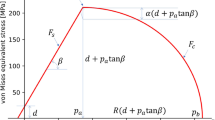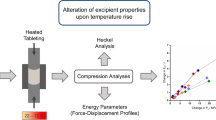Abstract
The aim of this study is to apply 3-D modeling to data obtained from different tableting machines and for different compression wheels on a linear rotary tableting machine replicator. A new analysis technique to interpret these data by 3-D parameter plots is presented. Tablets were produced on an instrumented eccentric tableting machine and on a linear rotary tableting machine replicator. The materials used were dicalcium phosphate dihydrate (DCPD), spray-dried lactose, microcrystalline cellulose (MCC), hydroxypropyl methylcellulose (HPMC), and theophylline monohydrate. Tableting was performed to different maximum relative densities (ρ rel, max). Force, time and displacement were recorded during compaction. The 3-D data plots were prepared using pressure, normalized time, and porosity according to Heckel. A twisted plane was fitted to these data according to the 3-D modeling technique. The resulting parameters were analyzed in a 3-D parameter plot. The results show that the 3-D modeling technique can be applied to compaction cycles from different tableting machines as different as eccentric and rotary tableting machines (simulated). The relation of the data to each other is the same even when the absolute values are different. This is also true for different compression wheels used on the linear rotary tableting machine replicator. By using compression wheels of different sizes on this simulator, mainly time plasticity changes. By using bigger compression wheels for simulation, the materials deform slower at lower densification and they deform faster at higher densification. For brittle materials, the stages of higher densification are influenced; for plastically deforming materials, the stages of lower and higher densification can be influenced.
Similar content being viewed by others
References
Picker KM, Bikane F. An evaluation of three-dimensional modeling of compaction cycles by analyzing the densification behavior of binary and ternary mixtures. Pharm Dev Technol. 2001;6:333–342.
Picker KM. A new theoretical model to characterize the densification behavior of tableting materials. Eur J Pharm Biopharm. 2000;49:267–273.
Picker KM. New insights into the process of tablet formation-Ways to explore soft tableting [Habilitationsschrift]. Halle, Germany: Martin-Luther-University Halle-Wittenberg; and Gorich und Weiershäuser Verlag, Marburg, 2002.
Schmidt PC, Tenter U. Force and displacement characteristics of rotary tableting machines. Pharm Ind. 1987;49:637–642.
Matz C. Evaluation einer IR-telemetrischen Kraft/Weg-Instrumentierung für Rundlauftabletten-pressen Differenzierung des Verformungsverhaltens direktkomprimierbarer Tablettierhilfsstoffe [Dissertation]. Freiburg, Germany: University of Freiburg; 1999.
Matz C, Bauer-Brandl A, Rigassi T, Schubert R, Becker D. On the accuracy of a new displacement instrumentation for rotary tablet presses. Drug Dev Ind Pharm. 1999;25:117–130.
Rippie EG, Danielsson DW. Viscoelastic stress/strain behaviour of pharmaceutical tablets: analysis during unloading and postcompression periods. J Pharm Sci. 1981;70:476–482.
Oates RJ, Mitchell AG. Calculation of punch displacement and work of powder compaction on a rotary tablet press. J Pharm Pharmacol. 1989;41:517–523.
Oates RJ, Mitchell AG. Comparison of calculated and experimentally determined displacement on a rotary tablet press using both Manesty and IPT punches. J Pharm Pharmacol. 1990;42:388–396.
Oates RJ, Mitchell AG. A new method of estimating volume during powder compaction and the work of compaction on a rotary tablet press from measurements of applied vertical forces. J Pharm Pharmacol. 1994;46:270–275.
Krumme M. Entwicklung rechnergestützter Verfahren zur Kompressions: und Festigkeitsanalyse von Tabletten [Dissertation]. Berlin, Germany: Free University of Berlin; 1992.
Krumme M, Schwabe L, Frömming KH. Development of computerised procedures for the characterization of the tableting properties with eccentric machines. High precision displacement instrumentation for eccentric tablet machines. Acta Pharm Hung. 1998;68:322–331.
Levin M, Tsygan L, Dukler S, inventors. Press simulation apparatus. US patent 6 106 262. December 23, 1998.
MCC Corp. The Presster Binder [technical information]. East Hanover, NJ: The MCC Corp; 2000.
Picker KM, Mielck JB. True density of swellable substances at different relative humidities-a new approach to its determination. Eur J Pharm Biopharm. 1996;42:82–84.
Heckel RW. Density-pressure relationships in powder compaction. Trans Metall Soc AIME. 1961;221:671–675.
Heckel RW. An analysis of powder compaction phenomena. Trans Metall Soc AIME. 1961;221:1001–1008.
Author information
Authors and Affiliations
Corresponding author
Rights and permissions
About this article
Cite this article
Picker, K.M. The 3-D model: Comparison of parameters obtained from and by simulating different tableting machines. AAPS PharmSciTech 4, 35 (2003). https://doi.org/10.1208/pt040335
Received:
Accepted:
DOI: https://doi.org/10.1208/pt040335




